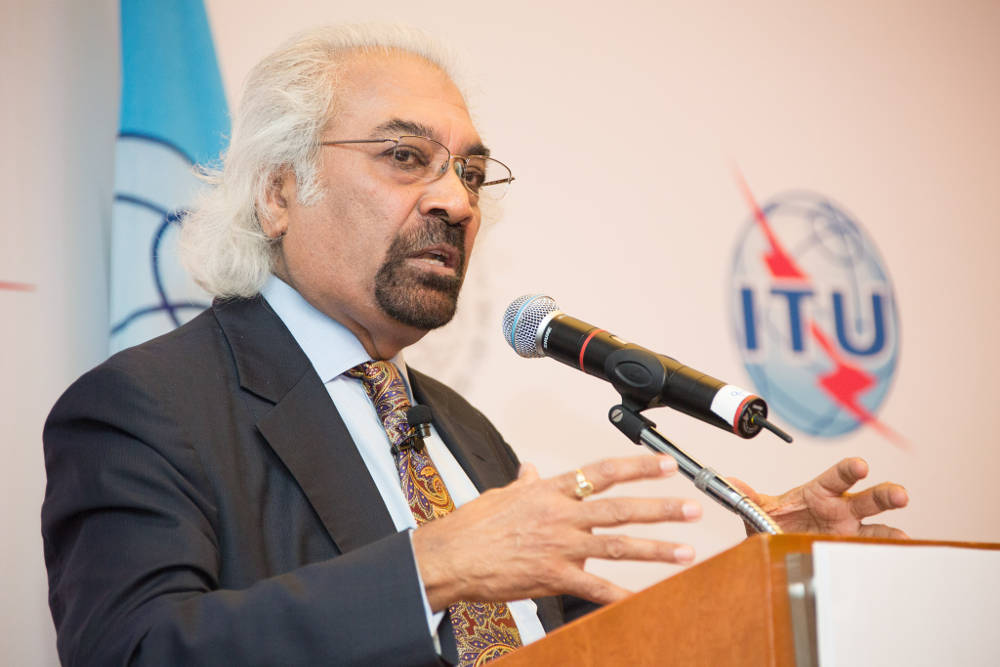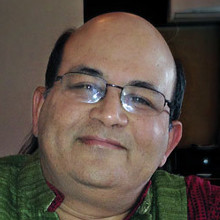[Photograph of Sam Pitroda by ITU Pictures under Creative Commons]
Sam Pitroda visited the Indian Institute of Management (IIM) Indore recently. Before his visit, I was wondering whether he would be able to connect with our young students—after all he is now old enough to be their grandfather, and his most significant achievements in India were three decades ago. I was happy that my doubts turned out to be completely unfounded; not only did he connect well, but he enthralled, motivated and energized the audience with stories from his autobiography (Dreaming Big: My Journey to Connect India, with David Chanoff, Penguin Portfolio, 2015).
Pitroda’s life and mine have had some curious interconnections, some of them at a distance, and others more proximate. Pitroda set up the Centre for Development of Telematics (C-DOT) in 1984. I can still recall the incredulity with which the media and the public treated the announcement that C-DOT under his leadership intended to develop modern electronic exchanges within 36 months. At that time telecom in India was bad, really bad. I was a student at the Indian Institute of Technology (IIT) Kanpur and one of the lucky few who had a phone at home in Madras, as Chennai was then called, at the other end of India. But getting through on the phone was an uncertain, costly adventure and we rarely tried, preferring good old snail mail. Yet, as stories started emerging from some of our seniors who joined C-DOT, we learnt that Pitroda meant business. We heard about the challenging yet egalitarian work environment he had created, and the talented IITians who joined C-DOT instead of going abroad on a scholarship (which was very easy to obtain in those days) seemed to be doing exciting work and enjoying themselves.
Fast forward a few years. In 1987, I returned from the US after completing my masters and joined my father’s company. The Department of Telecom (DoT) was our major customer, only our product (antennas) was used in transmission rather than switching. C-DOT’s first product, the Rural Automatic Exchange, started getting traction as it was inducted in the network, and became well-regarded for its ruggedness and ability to work in India’s difficult environment. Reports from within C-DOT were good, morale was high, and C-DOT continued to be seen as a good employer.
Things moved fast in the next couple of years. Pitroda became the head of DoT itself as he fought to overcome the obstacles to the induction of C-DOT’s next product, the Main Automatic Exchange (MAX). As per reports at that time, this became necessary as the DoT tried to block acceptance of the MAX by requiring unattainable, contradictory specifications. As a small supplier to the DoT, we watched with amusement as Pitroda tried to simplify the structure of the department by, for example, simplifying designations—at that time, an assistant engineer in the field heading a taluka used to be called a sub-divisional officer telecom (SDOT) and an assistant director when posted at headquarters. Pitroda sought to give all assistant engineers a single designation. But, by 1989, Rajiv Gandhi had lost power, the new government launched a witch-hunt against C-DOT and Pitroda, and Pitroda soon had to resign from the DoT. C-DOT slowly disintegrated thereafter but not before it had managed to complete development of the MAX technology.
Honestly, at that time, it was difficult to gauge Pitroda. Was he really a technical whiz? Or was he just a smart-talking manager who was good at motivating people? Who was this guy who in less than a decade moved from being an unknown person to become head of India’s (then monopoly government-owned) telecom network?
But it was clear that he had achieved something. The EPABX and RAX designed by C-DOT were robust and reliable. They were also inexpensive. A private telecom manufacturing industry grew up around the C-DOT technology where none existed previously. For the first time in the history of independent India, publicly-funded R&D resulted in tangible output that made a difference to people’s lives as the C-DOT equipment, combined with the imported large exchanges installed in cities, became the backbone for a national digital telecom network that allowed people to converse with each other through privately operated public call offices (PCOs).
These PCOs were a lifeline for everyone. I was no exception as I joined the doctoral programme at IIM Ahmedabad in 1991 and used local PCOs to keep in touch with my parents. I was intrigued enough by what C-DOT had achieved to write a term paper on C-DOT for my Organization Theory class. The material for the term paper came from some interviews that Pitroda had given to the media along with some inputs I had from friends who had worked at C-DOT.
Fast forward again to 2004. Though there was broad international acknowledgement that the world had reached a stage where knowledge was displacing capital as the key resource required for progress, India for the first time took this seriously by setting up the National Knowledge Commission (NKC) under Pitroda’s chairmanship. Innovation was one of the important themes of the NKC and I can recall being invited to a meeting with the NKC members on this subject at the Infosys campus around 2005. The NKC was broad in its sweep and came out with some well-written reports and documents. But, looking back today one would have to say that except for the National Knowledge Network connecting educational and research institutions, the NKC made little impact. Some of its most basic recommendations such as reducing or removing government’s role as a regulator of higher education and the creation of a single integrated body to oversee higher education to replace the University Grants Commission (UGC) and the All India Council for Technical Education (AICTE) never materialized.
To be fair to Pitroda, he realized this. When the National Innovation Council was set up in 2010, I was excited that the government had, at last, recognized the importance of innovation in taking India forward, and sent him a congratulatory email. He called me a day later from Chicago, and emphasized that the innovation council would focus on catalyzing actual innovation rather than producing reports. Again though, unfortunately, except for the Innovation Council’s successful efforts in modernizing some traditional clusters, it appears that the Innovation Council’s achievements have been modest.
Making change happen in a large and complex country like India is a huge challenge, yet given Pitroda’s access to, and influence with, the highest level decision makers of the country, it is legitimate to wonder why he couldn’t achieve more. Reading his book, my suspicion is that one reason is technophilia—an inordinate faith in technology to achieve desired outcomes. Not that Pitroda is not socially-sensitive—his modest background and family challenges during childhood have ingrained in him a sensitivity to the poor and under-privileged. But, at the core, he has remained a technocrat seeking essentially technical solutions to problems. It’s therefore not surprising that his most significant achievement in India is what he did at C-DOT 30 years ago.
And that’s not a bad achievement at all. In a country where publicly-funded technology development efforts have tended to drag on for years with limited results, he showed that “We can do it.” The youngsters who worked with him at C-DOT back then went on to become senior leaders in the Indian software industry, particularly in companies working in the telecom domain. The development of the C-DOT switches was perhaps the first large software engineering effort undertaken in India where principles of modern software project management and quality were applied. C-DOT’s technology laid the foundation for the telecom revolution that was to follow.
Pitroda has always been a visionary and dreamer. His enthusiasm and excitement about the future is intact at the age of 74. He first demonstrated his faith in Indian youth at C-DOT, and that faith continues undiminished till this day. This comes out loud and clear from the book, as it did in his talk at IIM Indore.
Where he might have made a mistake is in biting off more than he could chew. The later part of his autobiography has a long descriptive list of the multiple national and global initiatives with which he has been involved. Each of these would need a whole lifetime. I wonder whether he would have been more successful if he had been more focused. But then, perhaps he would not have been true to being Sam Pitroda.


